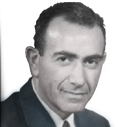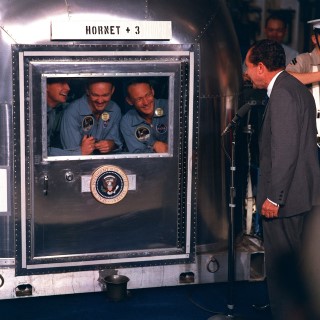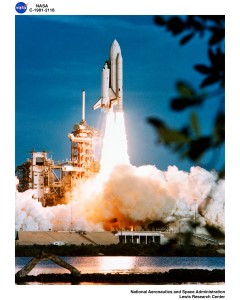President Nixon Visits Apollo 11 Crew in quarantine: President Richard M. Nixon welcomes the Apollo 11 astronauts aboard the U.S.S. Hornet, the prime recovery ship for the historic Apollo 11 lunar landing mission. Pictured are (left to right) Neil A. Armstrong, commander; Michael Collins, command module pilot; and Edwin E. Aldrin, Jr., lunar module pilot. Apollo 11 splashed down on July 24, 1969, about 812 nautical miles southwest of Hawaii.
Credit: NASA
The success of the Apollo program and results from the OSO and OAO satellite missions boosted our confidence in pursuing space science on a grand scale. Soon after taking office in January 1969, President Richard M. Nixon established the Space Task Group, composed of NASA engineers, to answer the question, "What’s next for NASA?” Their report, issued after the successful flight of Apollo 11, recommended a national space strategy that would include building a space transportation system to carry passengers, supplies, rocket fuel, other spacecraft, and equipment to and from orbit on a routine aircraft-like basis. I was appointed to the President’s Science Advisory Committee and chaired a panel in which we came around to the present space shuttle concept. The original idea of a fully recoverable system launched from the ground was going to cost over 13 billion dollars. President Nixon said he wanted us to come back with something closer to six billion, so a shuttle in which you dispose of the fuel tanks and bring back only the orbiter was the concept that we reached.
About the same time, a group of 90 scientists gathered for more than two weeks at Woods Hole, Massachusetts, to deliberate on priorities and recommend levels of effort and support to be allocated to the various NASA programs. I chaired the executive committee that produced the Priorities for Space Research 1971-1980 report in 1970, in which we recommended NASA initiate a new program to orbit a telescope of at least 1.5-m aperture. We also gave very high priority to begin the HEAO program to study X-rays, gamma rays, and cosmic rays.
The timing was right. Research in high energy astronomy was ready for major advances that could be expected from the large-volume payloads HEAO could carry. Two missions were deemed essential, a scanning mission, and a pointed mission.
space shuttle: As humanity's first reusable spacecraft,NASA's space shuttle fleet began setting records with its first launch on April 12, 1981. Starting with Columbia and continuing with Challenger, Discovery, Endeavour, and Atlantis, the shuttle has carried people into orbit repeatedly, and launched, recovered and repaired satellites. The final space shuttle mission, STS-135, ended July 21, 2011 when Atlantis rolled to a stop at its home port, NASA's Kennedy Space Center in Florida. A sixth shuttle, Enterprise, was used for testing, but never flew in space. Two shuttles failed and crashed in flight, but the remaining four shuttles are on display at public viewing sites around the country.
Credit: NASA



